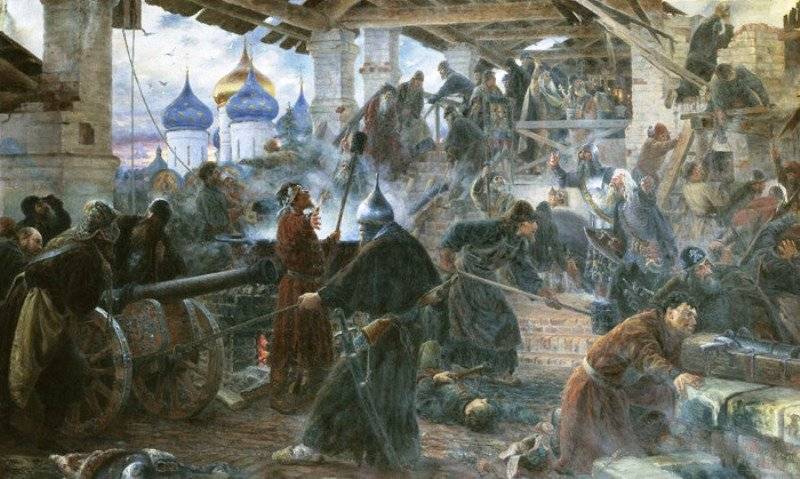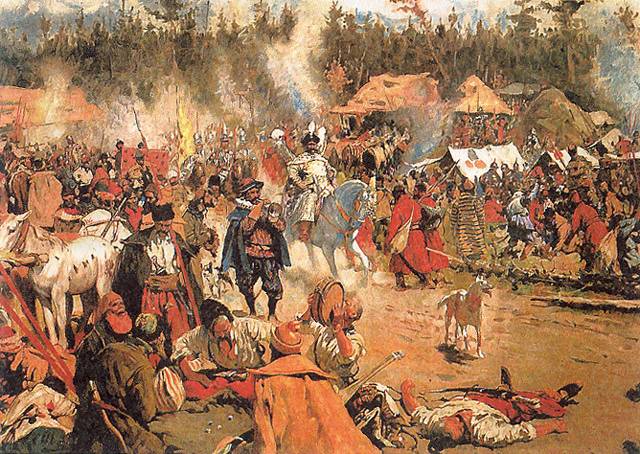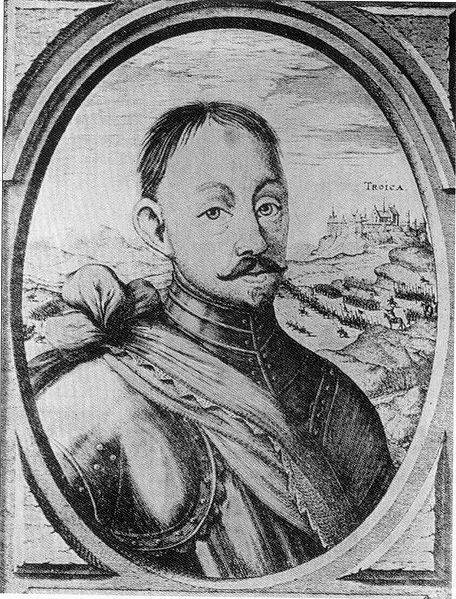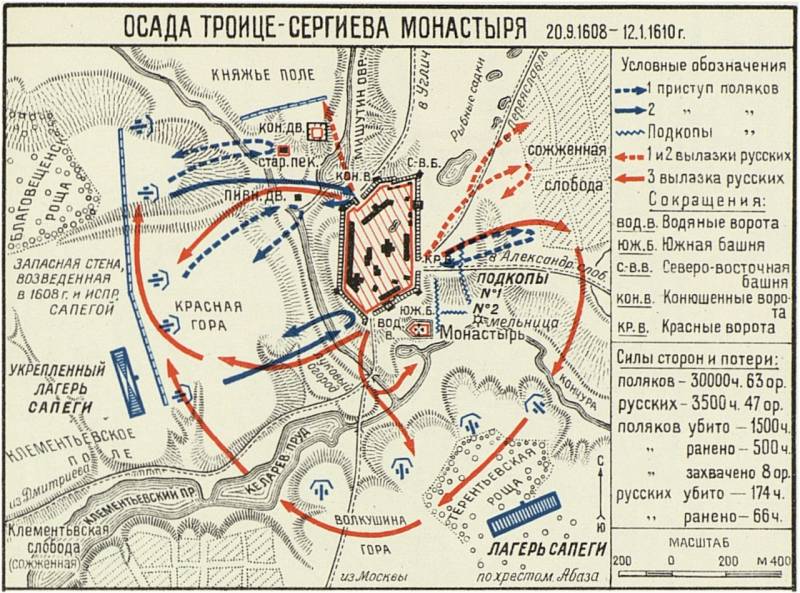How Polish and Russian "thieves" tried to capture the treasures of the Trinity

410 years ago, in January 1610, the heroic defense of the Trinity-Sergius Monastery ended. The siege of the monastery by the Polish-Lithuanian troops and Tushins lasted almost sixteen months - from September 1608 to January 1610. The enemy retreated due to the successful offensive of ratification of Prince Mikhail Skopin-Shuisky.
Tushino camp
The troubles in the Russian kingdom were in full swing. In the summer of 1607, a new impostor, False Dmitry the Second, appeared in Starodub. The battles of the royal governor with the supporters of the “true king” begin. The second impostor was less independent than Grigory Otrepiev. He was completely manipulated by the environment. From the very beginning, the real power under the "Tsar" belonged to the chieftain Ivan Zarutsky and the Pole Mekhovetsky, who was then ousted from the post of hetman by Roman Ruzhinsky. Polish gentry and adventurers still made up a significant part of the core of the impostor's army.
In addition, in the Polish-Lithuanian Commonwealth, the next confrontation of the Rocosans (rebellion against the king, to which the nobility had the right to protect their rights and freedoms) and the king, had just ended. In the decisive battle near Guz, the hetmans Zholkevsky and Khodkevich defeated the rebels. Then the Senate forced the king to reconcile with the vanquished. The troops were disbanded and a large number of mercenaries and gentry, both from the camp of the king and the Rokoshans, remained idle. They happily responded to the call of "Tsar Dmitry" and moved to Russia. The impostor's army has replenished with thousands of well-armed, experienced and professional fighters. This allowed the rat pretender to recover from previous defeats from the royal governor, and even increase. Now the tsar of Vasily Shuisky was opposed not only by rebellious serfs and thieves' Cossacks, but by the full-fledged horse corps of the Polish-Lithuanian Commonwealth, which by its fighting qualities at that time had no equal in Eastern Europe. Also, the army of the impostor was replenished by thousands of Cossacks and Don Cossacks of Zarutsky.
April 30 - May 1, 1608 the army of the impostor defeated the army of Prince Dmitry Shuisky on the Volkhov River and opened the way to Moscow. After the battle of Volkhov, the army of False Dmitry divided. Most of the troops passed through Kozelsk and Kaluga, faithful to “Tsar Dmitry”, and then through Mozhaisk came to Moscow from the west to avoid meeting with another royal army under the command of Skopin-Shuisky. False Dmitry troops camped in the village of Tushino, northwest of the capital. Therefore, they were nicknamed Tushins. The detachment under the command of Lisovsky moved on a long detour through the outskirts of Ryazan. Lisovsky’s troops occupied Mikhailov and Zaraysk; under Zaraysk, a sudden blow crushed the Ryazan army of Prince Khovansky and Lyapunov. As a result of this victory, Lisovsky with a quick attack captured the strong fortress of Kolomna and significantly replenished his forces due to the remnants of the previously defeated detachments of "thieves" (the troops of Bolotnikov and "Tsarevich Peter"). In June, in a battle near Bear Bear (on the Moscow River between Moscow and Kolomna), Prince Kurakin defeated Lisovsky, captured his "outfit" -artillery and a large convoy. The foxes fled to the Tushino camp.
From the summer of 1608 to the spring of 1610, Tushins were besieging Moscow. True, there were no forces for a full siege. In Moscow there was a whole army. Shuisky had every opportunity to replenish the garrison and supply the capital. At the same time, two systems of governing the country developed - in Moscow and Tushino. There were two kings, two governments with prizes, the impostor also had his own patriarch Filaret (Fedor Romanov), some cities were subordinate to Dmitry, others to Shuisky. The Tushinsky “Tsarek” generously distributed land to his supporters (they were taken from the supporters of Tsar Vasily), appointed governor to the cities. Tushins and Poles scattered throughout the country, trying to subdue as many lands and cities as possible, and seize their resources. With the arrival of the large detachment of the hetman Jan Sapieha to the impostor, detachments of "thieves" went to all parts of the country, trying to take possession of the rich regions. Some cities themselves “kissed the cross” of False Dmitry, others forced by force. The Poles of Sapega captured Pereslavl-Zalessky, Rostov, Yaroslavl, Vologda, Totma, then Kostroma and Galich. Foxers subjugated the interfluve of Klyazma and Volga from Vladimir and Suzdal to Balakhna and Kineshma. Pskov, part of the Novgorod land, Uglich and Kashin, was deposited from the king of Shuisk. The Volga was worried.

The beginning of the siege
Everything that happened was like the end of the world. Tushins - Poles and Russian "thieves", smashed and crushed any resistance. Robberies, wild atrocities and murders on a massive scale swept almost the entire European part of the state. Moreover, often the Russian "thieves" atrocities worse than the Polish-Lithuanian finds. The civil war took many different forms. "Moscow" robbed the monastery, patriarchs and palace lands to supply the capital. In response, the peasants created their self-defense units, asked for help from the Tushins, and themselves intercepted the supply lines of Moscow from Kolomna and Vladimir. Other peasants who were affected by the Tushins created partisan detachments and cut separate units of the impostor. The nobles split, some went over to the side of False Dmitry II (the so-called "Tushino flights"), others continued to stand for Tsar Shuisky, although his positions among the nobility were greatly shaken. The townspeople rose against the "strong people", the cities fought for different kings.
At the same time, Tushins encroached on the spiritual heart of Russia - the Trinity-Sergius Monastery. The monastery, founded by Sergius of Radonezh, at the beginning of the XVII century was the largest and richest monastery in the Russian kingdom. The fame of the monastery and especially its miracles, which came from the relics of saints and icons, brought thousands of pilgrims here annually, including merchants, boyars and the royal family. The monastery received rich monetary and land contributions, usually for a "mention of the soul." In the middle of the XVI century the monastery became a strong fortress - it was surrounded by a stone wall with 12 towers, where almost a hundred guns were placed.
With the beginning of the siege of Moscow by Tushins, the Trinity Monastery became an important strategic point. The monastery provided the connection of the capital with the northeastern regions, rich in Volga and Pomeranian cities. Therefore, the Shuisky government sent a detachment of archers and Cossacks to the monastery under the command of Grigory Dolgorukov-Grove and Moscow nobleman Alexei Golokhvastov. Also, the monastery was defended by posad residents, peasants and representatives of the clergy. The number of combat-ready part of the garrison was about 2,5 - 3 thousand people. The “nun queen” Martha (Princess Staritskaya) and the “nun princess” Olga (Godunova) were besieged.
The False Dmitry Government also appreciated the importance of the Trinity Monastery. Her capture allowed to strengthen the blockade of Moscow, cut it off from the east of the country. An important consideration was the looting of the monastery treasury, rich monastery volosts. For the Russian and Polish-Lithuanian "thieves" the robbery of the richest monastic treasury was the main incentive for the siege, especially after the recognition of "Tsar Dmitry Ivanovich" as Muscovites and many northern cities. Also, the transition of the local brotherhood to the arm of the "Tushino king" was to strengthen his authority in the country. Therefore, the detachment of Jan Sapieha went to the monastery, reinforced by Tushino "thieves" and Cossacks under the command of Lisovsky. The number of Tushino rati is estimated at about 12-15 thousand people with 63 guns (according to other sources - 17 guns). In the course of hostilities, the army of Sapieha and Lisowski could increase with the arrival of new units and decrease to several thousand when troops were serving to conduct hostilities in other places.
On September 23 (October 3), 1608, Tushino troops settled on the heights in front of the monastery. Tushintsy counted on an easy victory, that the monastery would quickly pass under the arm of “Tsar Dmitry”. However, the garrison "strengthened from treason" by kissing the cross at the relics of Sergius and resolutely rejected the offer of surrender. The Tushins burned the settlements surrounding the monastery and were forced to start a siege and build their fortified camp.
The shelling of the walls of rifles and light field guns, as well as a random attack, did not cause any positive effect. In early October, Sapieha had to start siege work. The Poles decided to make a dig under the Pyatnitskaya Tower, located in the central part of the southwestern wall. Then blow up the mine and make a breach. But the garrison learned about this from the defector and the "languages" captured during the sorties. The counterattacks of the fortress garrison made it possible to find out the place and direction of the enemy mine gallery. Enraged by the activity of the defenders of the monastery, Tushins opened fire on the temples from the heavy gun "Teschera", which was delivered from near Moscow. Shells damaged the Trinity Cathedral, the icons of the Archangel Michael and St. Nicholas the Wonderworker. In response, the clan’s artillery crushed the enemy’s battery.
November battle
On the night of November 1 (11), 1608, the Tushins made the first large assault, attacking the fortress from three sides. The enemy set fire to advanced wooden fortifications and thereby illuminated himself. The assault was reflected by the strong artillery fire of numerous artillery. Then the garrison made a sortie and destroyed individual groups of the enemy, who took refuge in a ditch. Tushins suffered significant losses. On November 9, the monastery’s defenders were divided into three detachments and made a general outing at night: “The yasak (battle cry - Author.) Sergiev’s name and together attacking Lithuanian people brazenly and courageously”. The attack was so sudden and decisive that the weaker regiments of the “city people” overturned the Tushins and captured 8 to 11 guns, prisoners, enemy banners and supplies. They were carried away to the fortress, and what they could not was burned. The Poles noted that the monks also participated in the sortie, some of them were real heroes.
On November 10, the Russian garrison repeated a sortie, trying to break through to the underground gallery. This time the Poles were ready and repelled the attack. The defenders suffered losses and retreated to the fortress. But something had to be done with a trench, he was rapidly approaching the Pyatnitskaya Tower. Taking into account the experience of previous battles, the besieged were especially well prepared for a new sortie at dawn on November 11. All forces were divided into several units, each got its own task. So the detachment of the hundredth head of Ivan Vnukov-Timofeev covered other units, and a group of demolitionists laid a charge in the undermining. The first strike was successful, a charge was laid in the undermining. Then the soldiers of Lisovsky counterattacked and nearly disrupted the operation. However, the soldiers of the detachment, Ivan Vnukov, who died in this battle, managed to detonate the charge and brought down the undermining. As a result, the fortress was saved.

Siege continued
After this major failure, Sapega changed tactics, abandoned attempts to take the fortress and concentrated his efforts on the close blockade of the Trinity. Tushintsy erected fortifications, blocked roads, put outposts and ambushes. The garrison command at first adhered to the previous tactics of active defense. In December 1608 - January 1609, the besieged carried out several sorties to capture food and fodder, destroyed and set fire to several outposts and fortifications. However, the garrison suffered serious losses, which he could not recover. In addition, during one of the sorties, Tushinsky blocked a squad of archers, which went beyond the walls, and then the Polish cavalry went on the attack and some of the riders were able to break into the monastery. The situation was saved by the numerous artillery of the Trinity, which with its fire supported the breakthrough of the archers back to the fortress. But they suffered significant losses. The Polish horsemen who burst into Trinity could not turn around in the closed narrow streets; they were killed by peasants with oak and stones.
Thus, the tactics of the Polish command bore fruit. Soon the garrison had to abandon the sorties. Cold, hunger, lack of drinking water and scurvy mowed the defenders. In February, 15 people died every day. Stocks of gunpowder were running out. The blockade claimed the lives of most of the defenders and other inhabitants of the Trinity. Mortally wounded and sick were tonsured as monks. Only a few survived the winter: according to Abraham Palitsyn, 2125 people were buried during the defense, “except for the female sex and the undergrowth and the weak and old.” By May 15, only about 200 children of the boyars, archers, Cossacks and monks remained in service.
But the remaining defenders were ready to stand to the end. They refused to accept all the new proposals of the Tushino residents for surrender. Moreover, people still walked behind the wall for firewood, water, roots, but already for several people. In turn, the tsarist governors tried to support such a heroic garrison, whose standing fettered the best enemy forces and gave hope to all opponents of the "Tushino king" and the Poles. In January, reinforcements could not break into Trinity, but in February a convoy with gunpowder from Moscow broke into the monastery. The convoy fell into one of the Tushino ambushes, and the Cossacks guarding it entered into an unequal battle, but governor Dolgoruky-Roshcha made a sortie and cleared the way.
Not everything was alright in the Trinity. There were quarrels between archers and monks. The chief governor Dolgoruky decided to take possession of the treasury and reserves of the monastery, accusing Joseph Trechkin of the monastery treasurer. But the second governor Aleksey Golokhvastov, with the support of the “nun queen” and archimandrite Joasaph, with the help of the monastic brotherhood, managed to justify the treasurer. There were also defectors who could not stand the hardships of the siege and fled to the Tushino camp. They informed the Poles about the extinction of the garrison from starvation and disease.
Sapega began preparations for a new assault. On the night of June 29, the besieged repulsed the enemy attack. Sapega began to prepare a new decisive assault, mobilized nearby Tushino detachments and brought his army to 12 thousand people. Against about 200 Trinity fighters! The defenders of the monastery were preparing to accept the final battle and death. On the night of July 28, the Tushins went on the attack. But the defenders were saved by a miracle. In the early morning darkness, Polish and Russian assault columns mixed up the time of the performance and moved differently. Faced among themselves, took in the dark allies for enemies and entered into battle. The turmoil began, many died, were injured and the assault broke. Conflicts began between Tushins and Poles, they accused each other of failures. After that, many Tushino leaders and Cossack chieftains, mistaking this case as a bad sign, left Sapieha camp.
Siege ending
After the failure of these assaults, a full-fledged siege was gone. Sapega led his detachment against the advancing troops of Skopin-Shuisky, who, with the support of the Swedes, led an offensive from Novgorod to liberate Moscow from the Tushins. Many atamans of Tushino citizens also took their people away, desertion intensified in the remaining units.
On October 18 (28), 1609, at the Aleksandrovskaya Sloboda (battle on the Karin field) Skopin-Shuisky defeated Sapege. Thus, he opened his way to the Trinity. After that, a detachment of governor Davyd Zherebtsov (several hundred soldiers) from the Skopin-Shuisky troops broke into the monastery. The garrison, having received reinforcements, resumed active hostilities. The supply of the Trinity was established. In January 1610, another detachment went to Trinity - governor Grigory Valuev (about 500 people).
As the troops of Skopin-Shuisky approached on January 22, 1610, the Poles lifted the siege and went towards Dmitrov. There in February they were again defeated. The remnants of the army of Sapieha left Dmitrov, and the Tushino camp fell apart. Polish-Lithuanian troops moved to the Smolensk region to join the army of King Sigismund III.
Thus, the enemy could not crush the walls of the monastery and the spirit of its defenders, plunder the treasures of the Trinity. The heroic defense of the Trinity-Sergius Monastery (together with Smolensk) showed an example of all Russia and the Russian people, strengthening the resistance and organization of the people in overcoming the Time of Troubles.


Information